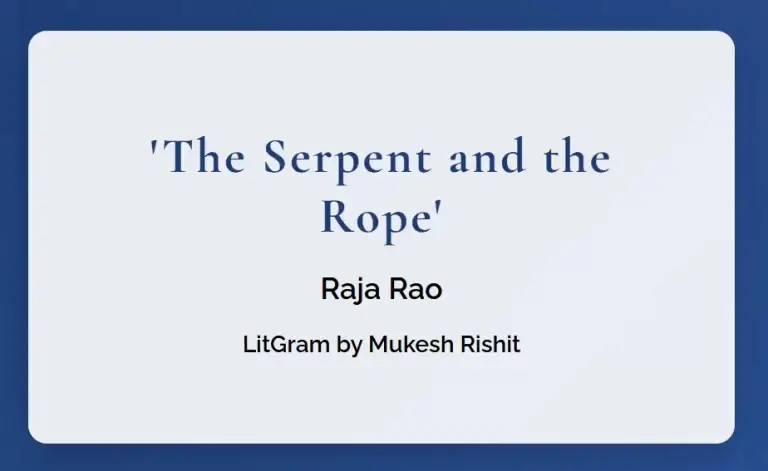Raja Rao’s The Serpent and the Rope is a masterpiece of Indian-English literature, blending philosophical musings, existential quests, and personal relationships into a deeply profound narrative. This blog post serves as a detailed guide covering all aspects of the novel, including its characters, themes, summary, analysis, and significance. Whether you’re preparing for an academic study, curious about the book’s philosophical undertones, or simply want to appreciate its literary richness, this guide has you covered.
Introduction to The Serpent and the Rope
Raja Rao’s The Serpent and the Rope, first published in 1960, is regarded as one of the greatest works of Indian-English literature. It is a semi-autobiographical novel encompassing themes of love, self-discovery, cultural identity, and spiritual growth. The title itself is steeped in Indian philosophy and allegory, making the narrative both accessible and complex to varying degrees of readership. At its heart lies the dichotomy between illusion (maya) and reality—a theme deeply rooted in Indian metaphysical traditions.
2. Historical and Cultural Context
About Raja Rao
Raja Rao was one of the pioneering authors in Indian literature written in English. A philosopher and novelist, he combined his personal experiences with spiritual insights drawn from the Vedantic tradition.
Postcolonial Backdrop
The novel was written during post-independence India, a time filled with introspection about individual and national identity. It explores these philosophical concerns, questioning the intertwining threads of history, culture, and personal experience.
3. Plot Summary
Detailed Summary
The novel follows Ramaswamy (Rama), a young Indian student in France, as he embarks on a journey of self-discovery. Rama is married to Madeleine, a French woman, whose differences in cultural and spiritual beliefs lead to the eventual breakdown of their marriage. Throughout the book, Rama navigates significant personal crises, such as madness, philosophical dilemmas, and the battle between attachment and detachment. Madeleine symbolizes Western rationality, while Rama embodies the spiritual aspirations of the East.
Eventually, Rama reconnects with his Indian traditions and his ex-wife Saroja, rediscovering a spiritual dimension that transcends his earlier conflicts. Their interactions mirror Raja Rao’s philosophical engagement with the concept of moksha (liberation).
Short Summary
A young Indian student in France, Ramaswamy, struggles to reconcile his identity, his marriage to a Frenchwoman, and his search for spiritual truth. Over time, he learns life’s greatest truths about love and detachment, rooted in Indian philosophy.
4. Characters in The Serpent and the Rope
Ramaswamy (Rama)
The protagonist, an Indian student who embodies a seeker torn between personal desires and spiritual pursuits. Rama represents the internal conflict faced by a modern individual navigating complex cultural terrains.
Madeleine
Rama’s French wife, who symbolizes Western ideals of rationality and logic. Her worldview often clashes with Rama’s spiritual leanings, leading to their separation.
Saroja
Rama’s estranged ex-wife from India, representing his rootedness in Indian ideals despite their earlier dissolution.
Supporting Characters
The narrative features many side characters who provide additional philosophical insights, functioning as foils or complements to Rama’s journey.
5. Themes of the Novel
- Search for Self: Rama’s quest mirrors an inner journey for self-realization.
- Cultural Dualism: The tension between Eastern spirituality and Western materialism is central to the novel.
- Love and Marriage: Relationships are portrayed as spiritual and philosophical battlegrounds.
- Maya and Moksha: A recurring theme that emphasizes transcending illusion.
6. Symbolism in the Title: The Serpent and the Rope
The title metaphorically presents the classic Advaitic notion: mistaking a rope for a serpent in dim light illustrates the illusion of reality. It implies the recurring human tendency to misinterpret reality due to ignorance (avidya).
7. Analysis of Writing Style
Rao’s prose mimics the stream-of-consciousness style seen in James Joyce while uniquely incorporating Indian oral traditions. The narrative seamlessly shifts between philosophy, personal anecdotes, and cultural commentary, maintaining an intimate tone.
8. Existential Philosophy in the Novel
Rama embodies existential dilemmas through his focus on self-awareness and purpose. However, his resolution lies in Vedantic teachings that emphasize discovering reality beyond superficial layers.
9. Summary in Hindi
The Serpent and the Rope की कहानी भारतीय संस्कृति और पश्चिमी समाज के दार्शनिक मतभेदों पर आधारित है। यह उपन्यास रामस्वामी के जीवन का अनुसरण करता है, जो आधुनिकता और परंपरा के बीच संघर्ष करता है। यह शरीर से आत्मा की मुक्ति तक की इंसान की आंतरिक यात्रा को दर्शाता है।
10. Reception and Criticism
Since its release, the novel has been lauded for its philosophical depth and profound depiction of cultural conflicts. Critics, however, note that its philosophical density can make it challenging for casual readers.
11. Downloadable—The Serpent and the Rope PDF
While many archives and ethical libraries host this text, always ensure you access it legally through verified sources like publishers or e-book platforms.
12. Detailed Summary
Raja Rao’s The Serpent and the Rope is a deeply philosophical and semi-autobiographical novel revolving around issues of identity, love, and spirituality. The story is narrated by Ramaswamy, commonly called Rama, a young Indian student and professor who lives in France. His marriage to Madeleine, a Frenchwoman, is at the heart of the narrative—a relationship that begins with mutual respect but ultimately disintegrates due to cultural and spiritual differences. Madeleine embodies the Western values of rationality and materialism, while Rama gravitates toward the spiritual ideals and metaphysical truths of the East. Their marital discord serves as the existential backdrop for Rama’s journey of self-discovery.
The novel explores Rama’s internal conflict between his attachment to Western life and his yearning for the spiritual rootedness of Indian philosophy. Rama is deeply influenced by the Advaita Vedanta tradition, which posits the oneness of existence and the pursuit of ultimate liberation (moksha). As his relationship with Madeleine deteriorates, Rama reflects on the nature of love, detachment, and the illusory nature of the material world (maya). When his marriage collapses, Madeleine retreats to a monastery, symbolizing her own withdrawal into spiritual isolation, while Rama returns to India.
Back in India, Rama reconnects with Saroja, his ex-wife from an earlier failed marriage. Saroja, in many ways, represents his spiritual grounding and Indian heritage. Through their interactions and Rama’s rediscovery of Indian traditions, he evolves into a deeper understanding of life’s dualities—illusion and reality, the transient and the eternal. The title, The Serpent and the Rope, metaphorically illustrates this journey, referring to the Advaitic concept that humans often mistake illusion (serpent) for reality (rope) until they attain self-realization.
Ultimately, the novel does not offer clear resolutions but instead emphasizes the ongoing quest for truth and spiritual awakening. Ramaswamy’s struggles embody the universal tension between material existence and spiritual transcendence, making The Serpent and the Rope a profound exploration of identity, culture, and philosophy.
13. Why The Serpent and the Rope Matters Today
Despite its philosophical roots, the novel’s exploration of identity, relationships, and cultural synthesis remains incredibly relevant in the age of globalization. Readers worldwide grapple with these questions of belonging.
14. Awards and Legacy
The novel won critical acclaim and solidified Raja Rao’s reputation as a classic writer. It has inspired a generation of authors exploring East-West dynamics and philosophical fiction.
15. FAQs About The Serpent and the Rope
- What does the title The Serpent and the Rope symbolize?
It symbolizes the Indian philosophical idea of mistaking illusion (serpent) for reality (rope). - Who are the primary characters in the novel?
Ramaswamy, Madeleine, and Saroja are central to the story, representing different philosophical and cultural ideas. - What are the major themes of the book?
Self-discovery, cultural conflict, marriage as a spiritual journey, and overcoming illusion (maya). - Is the book autobiographical?
Yes, the novel draws heavily on Raja Rao’s personal experiences, particularly his time in France. - What makes The Serpent and the Rope significant in Indian literature?
Its fusion of Indian philosophy with Western narrative styles sets it apart as a landmark in Indian-English fiction.
The Serpent and the Rope isn’t just a novel—it’s an existential and spiritual journey. Whether you’re someone delving into it for academics or personal curiosity, it leaves every reader with profound questions about life, love, and reality. Happy reading!


